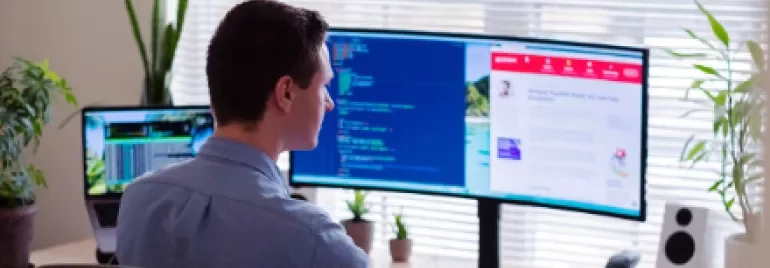Leadership from a distance: navigating remote work



Hiring is getting harder. The global talent shortage and access to relevant, up-to-date skill sets are the biggest challenges facing companies and hiring managers alike. That is why offering location-independent options undeniably swells the employee talent pool from which to recruit executives.
Employers offering remote options make it possible for future leaders from around the globe to apply without relocating. This is especially important among workers under 35, 68% of whom say remote options greatly impact their decisions whether to work for a company, or not – according to a Fundera report.
Zuca Palladino, Partner North America, says, “Hiring remotely definitely widens the talent pool. If you have a top performing executive in the Midwest, why risk disrupting this person’s career and personal life to send them to another location if they can perform the role from where they are? There’s no one rule that fits all, but if that executive is managing a multi-location/global team, it will benefit everyone to invest in a remote work strategy.”
Simon Nolan, Partner and Regional Head of the Consumer & Retail Practice UK explains that he has seen a clear trend over the last decade of increased location flexibility for senior leaders, which supports the widening of the talent pool – and improved work-life balance. “Companies and bosses are more flexible than they were 10 years ago when it comes to remote work. They’re thinking: ‘I want to be there for my family, so my workers should be able to be there for theirs too’,” he says.
So, how can senior executives reap the benefits of remote leadership, while minimising the risks? A strong company culture seems to be the key.
Working remotely is often a bed of roses: attractive with great potential for growth but filled with thorny issues.
Communications can lag. Getting people to meetings when they aren’t located in the same place means constantly navigating different time zones and mindsets. This can create conflict and chaos, and it was one of the main reasons tech giant IBM – a pioneer of remote working – blew the whistle and called employees back to the office in 2017.
When in-person meetings aren’t possible or practical, senior leaders can harness tech to make remote work seamless. Videoconferencing can help keep it (virtually) real. Live video feeds help remote workers see each other and interact in real time, wherever they are – the next best thing to a face-to-face meeting.
Again, culture is the cornerstone, and senior executives can embed communication as a practice and make regular check-ins part of daily working life so that remote workers don’t feel like they are alone.
According to a 2020 Workplace study, the more friends an employee feels like they have at work, the longer they will stay with a company. 43% of remote workers said that more face time would foster deeper relationships with their team, while eight in 10 feel they would have better relationships if their team communicated with them more.
That means you, as a leader, can foster a community, albeit online and through technology, which is invaluable in maintaining streamlined communications across distance.
However, although technology may connect a workforce, digital nomads often feel isolated. According to a 2017 Gallup Poll, working remotely is most effective when there’s a home–office balance. Engagement climbs when employees spend a proportion of their time working remotely and also work on location with their colleagues.
The optimal engagement boost occurs when employees spend 60% to less than 80% of their workweek – or 3 to 4 days – working off-site.
Engagement dips when employees work 40% to 60% of the time remotely, while employees who work remotely 100% of the time are among the least engaged.
Nolan advises senior executives to evaluate the benefits of remote work on a case-by-case basis – while reflecting the mirror on themselves, in terms of the engagement and productivity their teams show. “New hires and their leaders really should be in the office. You can’t take somebody who’s worked in the business for two weeks and say, ‘Off you go.’ They need training, they need to feel like they are integrated into the greater community and to learn by experience and from colleagues,” he explains.
There is a clear cost advantage for employers who can reduce overheads by moving their workforce to remote. The average real estate savings for US employers with full-time remote workers is US$10,000 per employee per year, according to PGi News. It’s win-win: remote workers also cut costs on expenses like commuting, food, clothing and childcare, saving around US$7,000 a year, according to figures from global IT recruiting company TECLA.
The number of people who work from home has increased by 140% since 2005. To manage the shift, senior executives must implement a strong company culture and clear expectations, to guarantee success.
Nolan recommends creating standard key performance indicators (KPIs) for management and employees “so that remote team members are aware of expectations, and their performance can be monitored. The KPIs are just one structured way for senior execs to understand how their teams are performing, alongside regular one-to-one chats and working feedback,” he explains.
The economic value of remote working, coupled with transparent expectations from leadership, helps companies not only attract but also retain the best talent. Stanford University research has found that remote work can boost employee retention: people who work outside of the office are 50% less likely to leave the company for pastures new.
According to a Buffer Study, 90% of remote workers plan on working remotely for the rest of their careers, and 94% actively encourage others to work remotely.
A successful remote working strategy can be exponentially rewarding for employers, employees and recruiters. The key is to maintain a strong internal company culture where future leaders build bonds with their team and companies maintain a cohesive and engaged workforce. This starts from the moment a candidate steps into the interview room.
“At Page Executive we work remotely. We see each other every Monday, but the rest of the week we work in different offices, from home, or we are on the road. It’s all about staying connected. That’s how you keep a team together. It requires effort, but it’s absolutely worth it. Luckily, with today’s productivity tools, it is a lot easier than it was in the past to stay connected,” says Tamara van Engelen, Associate Partner Europe.
Remote teams require effort to build and to drive towards productivity, but the rewards for the business — and the team themselves — can be counted.
If you are an employer and would like to discuss your hiring needs, fill in the form below and we will call you back.
